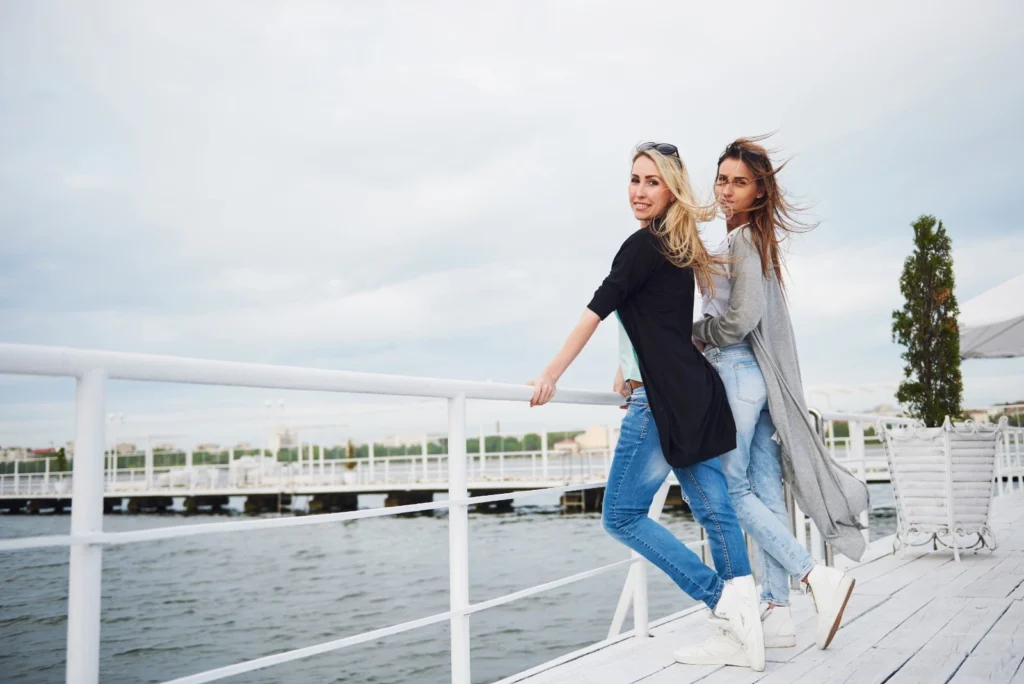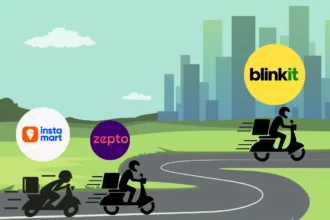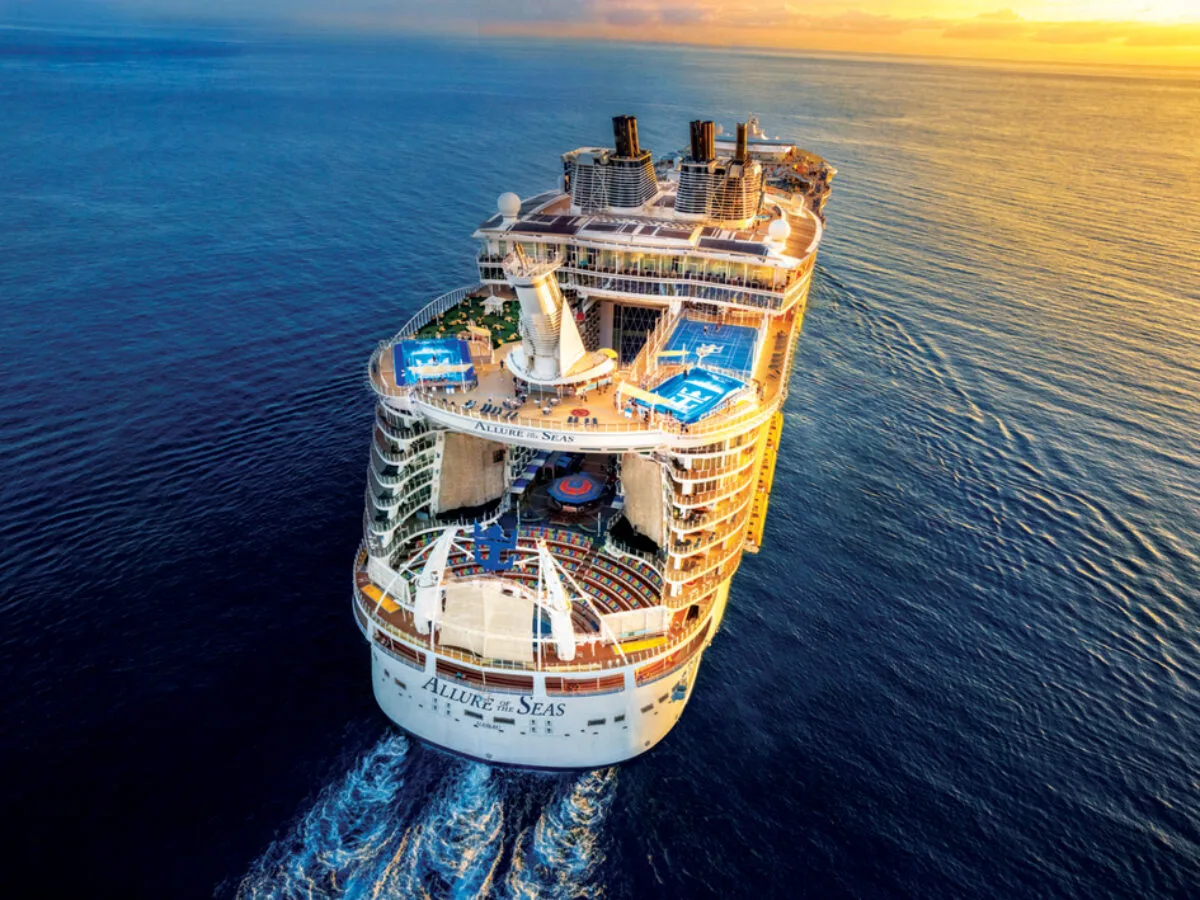Estimated Reading Time: 25-28 minutes ( 4,902 words)
Introduction
If there’s one travel trend making serious waves in 2025, it’s cruising — and not just in the Caribbean or Mediterranean. After years of pandemic turbulence, cruise tourism has bounced back harder and faster than many expected. Ships are fuller, itineraries are longer, and cruise lines are launching some of their most ambitious vessels ever. From mega-resorts on water to intimate expedition ships exploring polar regions, the world is rediscovering the joy of slow, scenic, all-inclusive travel. And the vibe for 2025? Think “revenge travel meets floating luxury hotel.”
What makes this year even more exciting is the shift in who’s boarding. A younger, experience-hungry audience — Gen Z, millennials, digital nomads — is joining seasoned cruisers. Add in the fact that cruise costs often beat hotel vacations (hello, all-you-can-eat buffets and unlimited entertainment), and suddenly cruising isn’t just a retiree bucket-list thing anymore. Governments are also doubling down: ports are expanding, visas are easing, and countries are offering cruise-friendly policies. India especially is pushing hard, with the Cruise Bharat / Cruise India mission aiming to turn the country into a global cruise hotspot.
For Indian travellers — a segment once barely visible in cruise statistics — 2025 is shaping up to be the breakthrough year. Affordable short-haul Asian itineraries, new Indian ocean routes, improved domestic ports, and rising aspirational spending are turning curiosity into bookings. Whether it’s families eyeing 3-night getaways, young couples seeking luxury escapes, or explorers itching for river cruises along the Ganga and Brahmaputra, cruising is finally getting its India moment. As Cruise Lines International Association (CLIA) notes, global demand is hitting record highs — and India is no longer watching from the shore. It’s stepping onboard.

Quick data snapshot (global + India)
- Global passengers (2024): 34.6 million ocean-going cruise passengers sailed in 2024. Cruise Lines International Association
- CLIA 2025 forecast: the industry is forecast to welcome 37.7 million ocean-going passengers in 2025 and reach ~310 ocean-going vessels. Cruise Lines International Association
- Global revenue (2024): market reports place 2024 cruise revenues around $71B (industry estimates). Skift Research
- India (FY 2024–25): 4.92 lakh (492,362) sea-cruise passengers and 272 cruise calls; the Cruise Bharat / Cruise India Mission runs through Mar 2029 to scale ports, clearances and river-cruise plans. Press Information Bureau+1
(These five statements are load-bearing and drawn from CLIA, PIB/GoI and market research reports.)
What’s Driving the 2025 Cruise Boom? (7 Trends)
1) Post-pandemic rebound + the “experience-first” travel mindset
While several tourism segments struggled to return to pre-2020 levels, cruises bounced back at remarkable speed. According to Cruise Lines International Association (CLIA), global passenger volume has now surpassed pre-pandemic figures, driven largely by travellers craving structured, all-inclusive, stress-free vacations. The desire for “one booking, one ship, many experiences” has fueled record advance bookings for 2024–2025. Families, multi-generational groups, and long-term travellers are choosing cruises because they offer reliability — something people missed during the volatile travel years.
2) Younger travellers are reshaping the cruise market
Gone are the days when cruising was viewed as a retiree playground. Millennials and Gen Z are now the fastest-growing cruise demographic, per CLIA, drawn to themed sailings (music, gaming, wellness), adventure itineraries, and Instagrammable moments. Expedition cruising, immersive port excursions, and “slow travel at sea” strongly resonate with them. Younger Indians are also joining in — especially couples seeking luxury honeymoons, creators looking for content-friendly experiences, and groups booking short 3–5 night cruises around Asia.
3) Luxury & expedition cruising is exploding globally
Small-ship expedition cruising — think Antarctica, Arctic, Galápagos, and remote island itineraries — has become one of the highest-yield categories. CLIA notes that these vessels have near-full occupancy and premium pricing, driven by affluent travellers who prefer curated, boutique, high-touch experiences. Many luxury brands are doubling their expedition fleets, adding submarines, helicopters, and science-led excursions. This segment also appeals to India’s rising HNI/ULTRA-HNI class, who are increasingly booking South Pole, Arctic Circle, and Patagonia itineraries.
4) Massive fleet expansion & next-gen newbuilds
2025 will see one of the largest waves of ship deliveries in recent years. Cruise lines are launching bigger, greener, tech-enhanced vessels, with features like AI-based crowd management, energy-efficient propulsion, and immersive entertainment domes. Every new ship means increased global capacity — and to fill that capacity, operators are expanding itineraries into new or underserved regions. This creates opportunities for markets like India, Southeast Asia, and the Middle East to be included in repositioning routes, homeporting, and seasonal sailings.
5) Asia’s big comeback — and India’s strategic position
With North America and Europe saturated, cruise lines are rebalancing toward high-growth Asian markets. More ships are being deployed for Southeast Asia circuits (Singapore–Malaysia–Thailand), Japan–Korea loops, and long-haul repositioning voyages from the Middle East and Australia.
According to Tourism Analytics, Asia is one of the fastest-growing cruise regions post-2023. India stands to benefit in two ways:
- Outbound Indian cruisers now have more short, affordable cruise options from Singapore, Dubai, and Tokyo.
- In India itself, ports like Mumbai, Goa, Kochi, Chennai, Vizag, and Port Blair are being considered for increased calls and homeporting.
6) Sustainability, fuel rules & clean-energy reforms reshaping cruising
Environmental regulations are pushing cruise lines to modernize quickly. As Reuters highlights, new IMO fuel rules, onshore power requirements, and decarbonization commitments are transforming ship design and port infrastructure. This is not just a cost challenge — it’s shaping itinerary planning: ships prefer ports with strong environmental compliance, cleaner bunkering, and adequate green-energy support. India’s port modernization under the Maritime India Vision aims to align with these standards, improving the country’s readiness for high-capacity vessels.
7) India’s government support and “Cruise Bharat” push
The Cruise Bharat / Cruise India mission is giving cruising its biggest push yet. As per the Press Information Bureau (PIB):
- Ports are undergoing ₹45,000+ crore upgrades in passenger amenities, terminals, and berthing spacing.
- Immigration and customs processes are being digitized and simplified, reducing turnaround time.
- Marketing campaigns are promoting both coastal cruises (Mumbai–Goa, Kochi–Lakshadweep) and river cruises (Ganga, Brahmaputra).
The result? India is actively positioning itself as a cruise-capable, cruise-ready market that global operators can no longer ignore.
India-specific developments: Cruise Bharat Mission & ports
India’s Cruise Bharat / Cruise India initiative (phased: Oct 2024 – Mar 2029) aims to expand cruise calls, develop homeport capability, grow river cruising on national waterways, and create employment. The government reports 4.92 lakh passengers and 272 cruise calls in FY 2024–25, and is investing in digitized immigration/customs (Cruise QR code, e-clearances) to reduce friction. The goal: scale turnarounds, promote regional circuits (Andamans, Maldives, Sri Lanka launches), and position India as both source market and hub for South Asia itineraries. Press Information Bureau+1Implication for travellers & businesses: better gateway procedures, potential for more homeport sailings from Mumbai/Goa/Kochi, and new river cruise product opportunities on the Ganga and Brahmaputra.
Top Itineraries From India (Sea & River)
India’s geographic stretch across the Arabian Sea, Bay of Bengal, and the subcontinent’s vast river network has unlocked a mix of short, scenic coastal cruises and iconic river journeys. Whether travellers want weekend getaways, cross-border cultural circuits, or luxury expedition-style voyages, 2025 offers more choices than ever. Below is a comprehensive breakdown of the most popular and in-demand routes.
A) SEA ROUTES (POPULAR 3–7 DAY OPTIONS)
1) Mumbai → Maldives (3–5 Days)
This is one of the fastest-growing Indian outbound cruise circuits, especially among luxury and honeymoon travellers.
Highlights:
- Island-hopping stops at Malé, Maafushi, Addu Atoll
- White-sand beaches, water villas, snorkeling & diving packages
- Premium positioning — often on luxury ships or repositioning voyages
Ideal For: Couples, families, luxury travellers, content creators
Why Popular in 2025: Direct sailing from India reduces flight costs, making Maldives more accessible.
2) Mumbai / Goa → Sri Lanka Loop (5–7 Days)
This multi-country circuit blends Southern India + Sri Lanka in a single cruise, offering a strong cultural and nature mix.
Typical Ports: Mumbai/Goa → Kochi → Colombo → Hambantota → Trincomalee
Highlights:
- UNESCO heritage sites (Sigiriya, Galle Fort)
- Wildlife safaris & tea estate visits
- Sri Lanka’s growing popularity as a budget international destination
Best For: Families, older travellers, culture lovers
2025 Note: Sri Lanka is increasingly featured in Southeast Asian itineraries due to stable tourism recovery.
3) Chennai / Kochi → Andaman Islands (6–8 Days)
A more adventurous and seasonal route, ideal for nature and diving enthusiasts.
Typical Ports: Chennai → Port Blair → Havelock / Neil Islands
Highlights:
- Radhanagar Beach (often ranked among the world’s best)
- Coral reef diving & adventure sports
- Cultural visits (Cellular Jail, Ross Island)
Why Seasonal: Sea conditions in the Bay of Bengal limit year-round departures.
4) Western India Coastal Circuits (Mumbai → Goa → Mangalore) (2–4 Days)
The weekend cruise that’s driving domestic adoption.
Features:
- 2-night “party cruise” itineraries
- Goan beaches + Mangalorean seafood tours
- Budget-friendly sailing options
Audience: First-time cruisers, young groups, corporate outings
Trend 2025: These short-haul coastal circuits are critical for making cruising mainstream in India — low cost, low commitment, high impact.
B) RIVER CRUISES (GANGA & INLAND WATERWAYS)
India’s river cruising market is small but rising sharply — attracting foreign travellers, affluent Indians, and culture-focused explorers. These itineraries offer slow travel, heritage experiences, and access to regions untouched by mainstream tourism.
1) Varanasi → Kolkata (Ganga Luxury Segments, 7–10 Days)
This is India’s flagship luxury river cruise corridor, heavily promoted in international markets.
Route Highlights:
- Varanasi ghats & sunrise ceremonies
- Mughal, colonial & Bengali heritage towns
- Serampore, Chandannagar (French & Danish history)
- Rural village visits and onboard cultural shows
Experience Level: Boutique, premium, all-inclusive
Why Travellers Love It: It blends spirituality, history, cuisine, and landscapes in a single curated itinerary.
2) Brahmaputra Expeditions (Assam, 7–12 Days)
One of the world’s most unique river journeys — rugged, intimate, and high-yield.
Typical Route: Guwahati → Kaziranga → Majuli → Sibsagar
Highlights:
- Jeep safaris in Kaziranga National Park
- Visits to Majuli, one of the world’s largest river islands
- Vaishnavite monasteries & tribal cultural tours
- Opportunities for birding, wildlife spotting, and riverine exploration
Target Audience: Wildlife enthusiasts, photographers, luxury experiential travellers
Pricing: Higher than sea cruises — but also higher profitability for operators.
Who Operates These Routes?
India’s cruise ecosystem is now a mix of:
- International cruise lines (deploying regional Asian ships with India calls)
- Domestic sea-cruise operators (coastal circuits)
- Indian river-cruise companies (Ganga & Brahmaputra)
- Joint-venture operators expanding expedition-style offerings
New collaborations in 2025 are expected to increase frequency and diversify itineraries across both coasts and rivers.
Cost Breakdown: Cruise vs Fly + Stay (Real Numbers for 2025)
Cruising often looks expensive upfront — but when you compare it against the combined cost of flights, hotels, meals, activities, and transfers, it can actually deliver equal or better value, especially for families. Below is a detailed snapshot using indicative 2025 pricing, based on industry data, Royal Caribbean pricing commentary, and Wall Street Journal travel cost trends.
Note: Prices vary by season, operator, cabin type, and booking window. These figures represent mid-season averages for 2025.
A) Typical Per-Person Cruise Pricing (2025 Estimates)
1) Budget Inside Cabin (Short Regional Cruise, 3–4 Nights)
Price Range:
- $150–$250 per night
- Total: ₹12,000–₹25,000 per person (for entire trip)
What’s Included:
- Accommodation
- All meals (buffet + dining rooms)
- Pool, theatre, shows, kids’ club
- Basic entertainment
- Port taxes + gratuities in some cases
Best For: First-time cruisers, families, weekend getaways, budget travellers.
2) Balcony / Premium Cabin (5 Nights, International or Repositioning Cruise)
Price Range:
- $200–$400 per night
- Total: ₹25,000–₹50,000 per person
Perks:
- Private balcony
- Better views
- Priority boarding in some ships
- Larger rooms and better amenities
Ideal For: Honeymoons, couples, families wanting ocean views, photographers.
3) Luxury River Cruise (5 Nights, All-Inclusive)
Price Range:
- $800–$2,500 per person
- ₹65,000–₹2,05,000 per person
Inclusions Typically Cover:
- All meals, premium dining
- Alcohol (select brands)
- Shore excursions
- Cultural shows
- Expert guides/naturalists
- Boutique-style accommodations
- Only 20–50 passengers onboard
Audience: Affluent travellers, foreign visitors, wildlife enthusiasts, seniors.
B) Real-World Comparison: Family of 4 (5 Nights, Mumbai → Maldives Cruise)
Assume mid-season pricing, 2 balcony cabins, 2 adults + 2 kids.
1) Cruise Option (All-Inclusive Style)
- Cabins (2 balcony cabins): ₹1.8–2.4 lakh
- Meals (included): ₹0
- Entertainment / theatre / kids club (included): ₹0
- Onboard activities (mostly included): ₹0
- Taxes & port fees: ₹20,000–₹40,000
Total Estimated Spend: ₹2.2–3.2 lakh
Pros:
- No need to plan meals or transfers
- Kids’ programs save money on childcare
- Entertainment is included (shows, pools, events)
- Easier logistics for families
Potential Add-Ons:
- Specialty dining: ₹1,500–₹4,000 per adult
- Alcohol packages: ₹5,000–₹12,000 per day
- Internet: ₹1,000–₹2,500/day
- Shore excursions: ₹3,000–₹15,000 per person
2) Fly + Stay Option (5 Nights in Maldives)
- Round-trip flights for 4: ₹80,000–1.4 lakh
- 5-night mid-range resort: ₹1.2–1.8 lakh
- Local transfers (speedboat/seaplane): ₹20,000–90,000
- Food & drinks (5 days): ₹40,000–80,000
Total Estimated Spend: ₹2.5–3.5 lakh

Pros:
- Stay flexibility
- More privacy
- Can choose cheaper or more premium hotels
Cons:
- Food costs extremely high in Maldives
- Seaplane transfers can be a hidden expense
- No included entertainment
- More planning required
C) Takeaway: Who Saves More With Cruises?
Cruises can be significantly more cost-effective when:
- Travelling as a family
- Wanting an all-inclusive experience
- Planning short regional itineraries (Singapore, Sri Lanka, Maldives)
- Avoiding expensive destination food/alcohol costs
- Want convenience over planning multiple bookings
The value of a cruise is often hidden in the “extras” it absorbs:
- Free kids’ clubs
- Free multi-course meals
- Broadway-style shows
- Zero transport between attractions
- Safe, walkable, all-in-one ship environment
Hidden Fees You MUST Watch For:
- Paid shore excursions
- Paid specialty restaurants
- Alcohol packages
- Internet packages
- Service charges & gratuities
- Spa treatments & casino spending
D) Summary
When comparing total trip value, cruises can match — and often beat — fly+hotel vacations for Indian families. The key is knowing what’s included, understanding add-on costs, and booking 45–120 days in advance to secure the best deals.
Booking Guide: Step-by-Step for First-Time Indian Cruisers
1. Decide the route, duration & cruise style
Start by identifying what type of holiday you want. Short 3–4 night regional cruises (Singapore, Malaysia, Thailand, Sri Lanka, Maldives) are perfect for beginners or families who want a low-commitment trip. Longer 7–14 night itineraries cover Europe, Alaska, Japan, Australia, or the Mediterranean and offer more activities, themed nights, and premium dining. Adventure travellers may prefer expedition cruises (Arctic, Antarctica, Galápagos) while seniors and culture-focused travellers often choose river cruises (Danube, Rhine, Nile, Mekong) because of calmer waters and easy port access.
2. Choose the right cabin class based on comfort & budget
Cabins vary widely in price and experience.
- Inside Cabin: No windows; most affordable; best for budget travellers who spend time outdoors.
- Ocean-View Cabin: A window or porthole; good balance of cost and comfort.
- Balcony Cabin: Private outdoor space; ideal for scenic routes like Alaska, Norway fjords, or Mediterranean sunsets.
- Suites: Large rooms, priority check-ins, concierge access; designed for luxury travellers, honeymooners, or families.
Many ships also offer family cabins, bunk-bed rooms, adjoining cabins, and accessible rooms. Always check deck plans—some cabins may be noisy (near elevators, engines, theatres).
3. Compare fares smartly using the right platforms
Cruise pricing fluctuates heavily due to demand, season, and cabin availability. Compare prices on:
- Cruise OTAs (cruise-only online travel agencies)
- Global aggregators (MakeMyTrip, Agoda, Expedia)
- Direct booking on cruise line websites
Sometimes cruise lines offer perks like onboard credit, free Wi-Fi, or drink packages when booking direct. If you run a blog or travel site, you can also integrate affiliate-powered cruise comparison widgets to monetize traffic.
4. Check visa, immigration & vaccination requirements early
Many itineraries require transit or multiple-country visas. For example:
- Singapore cruises require a Singapore visa.
- Europe cruises may require a Schengen visa.
- Some countries require border checks even if passengers don’t disembark.
Check ship-specific rules, as homeporting in India (Mumbai, Cochin, Goa) may reduce immigration steps for certain regional itineraries. Also check vaccination, yellow-fever certificates (Africa/South America), and updated advisories published by consulates or the Press Information Bureau.
5. Book shore excursions early — or plan DIY alternatives
Popular ports (Phuket, Mykonos, Santorini, Port Klang, Juneau) sell out quickly. Cruise-operated excursions guarantee you won’t miss the ship, while DIY tours using local guides or rideshare apps are cheaper but require time management. If you prefer adventure (kayaking, glacier hiking, scuba), reserve at least 2–3 weeks early.
6. Budget for onboard extras to avoid surprises
Cruises are semi-all-inclusive. Base fare usually covers food at main restaurants, shows, pools, entertainment and basic activities. Extras include:
- Wi-Fi packages (often expensive — buy early online)
- Specialty dining (steakhouses, teppanyaki, celebrity-chef restaurants)
- Alcohol & premium drinks
- Spa & salon treatments
- Gratuities/service charges (mandatory on some lines)
Setting aside an extra 20–40% of your cruise fare for extras is realistic for most Indian travellers.
7. Take cruise-specific travel insurance
Regular travel insurance may not cover situations like missed ship departure, medical evacuation at sea, or cruise cancellation due to weather. Choose policies designed for cruises, which include port delay benefits. This is also a good place for creators to insert affiliate insurance links.
8. Plan pre- and post-cruise hotel stays
Cruisers often reach the departure city a day early to avoid missing the ship due to flight delays. This is especially important for:
- Long-haul flights to Europe, US, Japan
- Monsoon or fog season in India
- Budget airlines with limited rebooking options
Post-cruise stays help extend your trip or manage late-night ship timings. Many travellers combine cruises with a city break (Singapore, Dubai, Barcelona, Tokyo).
Health, Safety & Sustainability: What Every Indian Cruiser Should Know
1. Health: Updated medical standards, personal precautions & seasickness planning
Cruises have significantly upgraded health and hygiene protocols in the post-pandemic era. Most modern ships now use hospital-grade air filtration systems (HEPA/UV-C), enhanced ventilation, and round-the-clock sanitation of high-touch surfaces. Onboard medical centers are staffed with doctors and nurses trained for emergencies, but treatment can be costly—so carrying the right insurance is essential.
Pack all necessary prescription medicines, a basic first-aid kit, and common remedies for seasickness, such as dimenhydrinate, sea-bands, or prescribed patches for sensitive travellers. If you have chronic conditions (diabetes, high BP, asthma, heart issues), get a doctor’s note, carry extra medication, and check if the ship can store medicines that require refrigeration. Pregnant travellers should check cruise-line policies—many impose limits after 24–26 weeks.
2. Safety: Ship protocols, port rules & smart travel habits
Every cruise begins with a mandatory safety drill that teaches essential evacuation and lifeboat procedures—pay close attention, especially if travelling with children or elderly parents. Follow shipboard rules regarding balconies, pools, and restricted areas; many incidents occur due to ignoring simple safety instructions.
When getting off at ports, check local advisories, weather alerts, and time restrictions; the ship will not wait for passengers late on shore excursions unless it’s an official cruise-run tour. Keep digital and printed copies of passports, visas, IDs, and travel insurance. For families, consider using AirTags/SmartTags in kids’ bags or shoes to avoid losing track in large ships with 4,000+ guests.
3. Sustainability: Cleaner ships, greener travel choices & responsible cruising
Cruise lines worldwide are under pressure to reduce environmental impact. Many new ships are adopting LNG (liquefied natural gas), hybrid engines, advanced wastewater systems, and shore-power capabilities, allowing ships to plug into local grids instead of burning fuel at port. Some itineraries also limit visits to environmentally sensitive destinations to avoid overtourism.
As a traveller, you can choose operators with strong ESG commitments—many publish annual sustainability reports (e.g., emissions per passenger, waste-recycling systems). Opt for itineraries that:
- Use ports equipped with onshore power
- Minimize fragile marine areas during peak seasons
Work with local communities for shore excursions
Small actions help too: carry reusable bottles, avoid single-use plastics, and respect wildlife viewing rules. If your audience values eco-friendly travel, highlight cruise lines that follow internationally recognized standards cited by global outlets like Reuters.
Risks & Headwinds for Growth
1. Port capacity limits & overtourism backlash
One of the biggest global headwinds is overcrowding at major cruise ports. European destinations like Barcelona, Venice, Santorini, and parts of Norway have already enforced stricter limits on daily ship arrivals, passenger disembarkation windows, and environmental compliance. According to multiple reports (including Reuters), some cities are pushing back against large ships due to congestion, pollution, and strain on local infrastructure.
For India, this creates a double-edged scenario: restricted European capacity may redirect some itineraries toward Asia and the Indian Ocean, but if not managed carefully, rising cruise traffic could trigger similar local dissatisfaction at ports like Goa, Mumbai, and Kochi. Without sustainable port planning, India could face its own version of the “Venice effect.”
2. Regulatory & decarbonization costs
The cruise industry is entering a decade of stricter environmental rules—from fuel-sulfur caps to requirements for LNG engines, shore-power compatibility, wastewater treatment upgrades, and future carbon taxes. These improvements are essential but expensive. The Wall Street Journal notes that as cruise lines invest billions in cleaner fleets, operating costs are rising—some of which will inevitably be passed on to travellers.
This could widen the cost gap between budget travellers and premium itineraries, making short regional cruises more popular but possibly slowing the growth of long-haul or luxury journeys from India.
3. Macro, geopolitical & insurance-related shocks
Cruises are extremely sensitive to global events. Conflicts, cyclones, piracy zones, port strikes, and sudden diplomatic tensions can force ships to reroute on short notice. Insurance premiums for certain regions can spike, and some routes may temporarily shut down, affecting both pricing and passenger confidence.
Examples include Middle Eastern tensions leading to Red Sea route diversions, or severe weather pushing operators to cancel Indian Ocean itineraries. While cruise lines generally handle disruptions well, these uncertainties remain a structural risk until global stability improves.
4. Awareness, affordability & perception barriers in India
Despite rapid growth, cruising in India is still far from mainstream. Many travellers believe cruises are:
- “Too expensive”
- “Only for the rich”
- “Boring for kids”
- “Only for older travellers”
This perception gap is a major barrier. The real challenge is educating middle-income families that 3–4 night regional cruises can cost as much as (or less than) a fly+stay vacation—especially when meals and entertainment are included.
Affordability remains an issue too; Indian travellers are highly value-driven. To scale the market, operators will need: - Short, high-value itineraries (Mumbai–Goa, India–Sri Lanka)
- Easy EMI options
- Clear price breakdowns with fewer hidden charges
- More influencer-led and regional-language marketing
Until cruising becomes a familiar, aspirational yet reachable category—like international travel did in the 2010s—mass adoption will remain gradual.
FAQs Section
1. Is cruising safe for Indian travellers in 2025?
Yes—cruising in 2025 is considered very safe, thanks to upgraded global standards. Modern cruise lines follow strict SOLAS (Safety of Life at Sea) regulations, continuous crew training, mandatory muster drills, and real-time weather routing to avoid storms.
Health-wise, ships now feature:
- Enhanced air filtration & upgraded ventilation systems
- Daily sanitation protocols in cabins and public areas
- Onboard medical centres with doctors, nurses, and emergency care
- Isolation cabins for suspected infections
For Indian travellers, the key is to: - Check the cruise line’s safety advisories
- Carry travel insurance with medical evacuation coverage
Inform the ship of any pre-existing health conditions
If you have chronic conditions (diabetes, hypertension, asthma), consult your physician and carry adequate medication.
2. Do I need a visa for cruise stops?
Maybe — it depends entirely on your itinerary.
Cruise visas are confusing because every country has different rules for:
- Transit passengers
- Passengers who disembark
- Nationality-based visa exemptions
Examples: - Maldives & Sri Lanka may allow on-arrival or ETA for Indians.
- Singapore & Europe require visas even if you’re only stepping off for a day.
- Some Middle Eastern ports allow shore visits without a prior visa if arranged by the cruise line.
Always confirm: - Whether all ports require a visa
- Whether your ship’s nationality affects requirements
Whether a Schengen visa is needed for European itineraries
Tip: Cruise lines publish “visa & documentation” pages for each sailing — check these 4–6 weeks before departure.
3. How much does a typical short cruise from India cost?
Short regional cruises (3–5 nights), departing from Mumbai, Kochi, or Chennai, usually cost:
- Inside cabin: ₹12,000–₹25,000 per person
- Ocean-view cabin: ₹18,000–₹35,000
- Balcony cabin: ₹30,000–₹60,000
Some premium international lines may go higher.
Extra costs to budget for: - Shore excursions (₹3,000–₹15,000 per port)
- Alcoholic beverages (₹400–₹900 per drink)
- Wi-Fi packages (₹1,200–₹5,000)
- Specialty dining (₹1,500–₹7,000 pp)
Tips/gratuities (₹900–₹2,000 per day depending on the line)
For families, cruising can be cost-effective because food, entertainment, kids’ programs, and cabin stays are bundled.
4. What’s the difference between sea cruises, river cruises, and expedition cruises?
Here’s a simple breakdown:
| Type | Ship Size | Experience | Best For |
| Sea Cruises | Large | Resorts at sea, multiple restaurants & shows | Families, first-timers, budget to premium |
| River Cruises | Small | Culture, heritage, city access, slow travel | Couples, seniors, history lovers |
| Expedition Cruises | Very small | Adventure, wildlife, remote regions (Arctic, Antarctica, Galápagos) | Luxury travellers, photographers, explorers |
Sea cruises = fun, big, entertainment-heavy.
River cruises = intimate, immersive, great for heritage circuits.
Expedition cruises = bucket-list, high-end, and educational.
5. Are there cruises that depart from Indian ports (homeporting)?
Yes. India has been building homeport capacity since 2016. Major ports offering turnaround cruises:
- Mumbai
- Goa/Mormugao
- Kochi
- Chennai
Under the government’s Cruise Bharat (Cruise India) initiative (Press Information Bureau), India is expanding: - Passenger terminals
- Digital clearances
- Shore infrastructure
Marketing campaigns
This means more 3–7 night itineraries from Indian ports in the coming years.
6. What vaccinations or health checks are needed for cruise travel?
Typically required or recommended:
- Routine vaccines: MMR, DTP, Polio
- Travel vaccines: Hepatitis A, Typhoid
- Destination-based vaccines (like Yellow Fever) depending on ports
Cruise lines may require: - Health declaration forms
- Proof of travel insurance (for remote itineraries)
Some river & expedition cruises recommend: - Fitness certificates
Altitude or cold-weather preparedness (if relevant)
Always check your cruise line’s “Health & Safety” section before departure.
7. Can Indians take river cruises on the Ganga or Brahmaputra?
Absolutely — and demand is rising fast.
India now hosts some of Asia’s most scenic and culturally rich river cruise experiences:
- Ganga luxury cruises: Varanasi ↔ Kolkata
- Brahmaputra expeditions: including Majuli island, Kaziranga safaris, Assamese culture
These cruises are typically operated by: - Indian boutique operators
- Indo-foreign joint ventures River cruises are more premium and experience-heavy, making them popular among NRIs, senior travellers, and foreign tourists seeking heritage immersion.
8. How do I avoid seasickness on a cruise?
Seasickness can hit even experienced travellers — here’s how to reduce the risk:
Before sailing:
- Book a mid-ship cabin on a lower deck (less motion)
- Avoid alcohol & heavy meals before departure
- Take OTC anti-motion medication (Dimenhydrinate / Dramamine)
- Bring ginger tablets or pressure bands
During the cruise:
- Stay on open decks during rough seas
- Focus on the horizon
- Eat light, stay hydrated
Visit the medical centre — they offer stronger anti-nausea treatments
Pro tip: River cruises rarely cause seasickness due to calmer waters.
9. What should families know about cruising with kids?
Cruising is one of the most family-friendly vacations today. Modern ships offer:
- Kids’ clubs (3–12 years)
- Teen zones (13–17 years)
- Themed activities, arcades, mini-golf, water parks
- Family cabins & connecting rooms
- Dedicated kids’ restaurants & menus
Parents must check: - Minimum age requirements (usually 6 months for most sailings)
- Swim diaper rules (most pools require full potty training)
Age limits for excursions (some require 6+ or 12+)
Tip: Book excursions directly with the cruise line for safety and easier logistics with kids.
10. How do I find the best cruise deals?
To maximize savings:
- Compare prices on cruise OTAs, aggregator sites, and the cruise line’s own website
- Sign up for fare alerts
- Check last-minute deals (2–6 weeks before sailing)
- Book during “Wave Season” (Jan–Mar) for big discounts
- Look for kids sail free promos
- Use bank offers, EMI schemes, or international cards with travel rewards If you run a travel site, inserting affiliate fare widgets can help users compare prices while earning you commissions.
12. Is Wi-Fi available on cruises?
Yes, but at a cost.
Modern ships offer:
- Basic internet packages (messaging only)
- Premium packages (video calls, streaming) Prices range from ₹1,200–₹5,000 per day depending on speed and cruise line. Tip: Buy Wi-Fi before sailing for discounts of 20–50%.
Summary / Key Takeaways
- The global cruise industry is growing again: 34.6M passengers in 2024 and a CLIA forecast of 37.7M in 2025. Cruise Lines International Association+1
- India is a small but fast-growing market — 4.92 lakh sea-cruise passengers in FY 2024–25; the Cruise Bharat Mission aims to expand ports and river cruising through 2029. Press Information Bureau
- Short regional cruises and river cruises are the high-opportunity products for Indian travellers and travel publishers.
- Monetization: mix affiliate bookings, insurance, lead magnets, and high-CPC ad keywords.
- Risks: port capacity pushback, environmental regulation costs, and awareness/affordability gaps in India.

Conclusion
Cruising in 2025 is no longer the “foreign fantasy” Indians once associated only with Europe, the Caribbean, or Hollywood movies. It’s rapidly transforming into a real, accessible holiday option—powered by India’s growing spending power, younger travellers seeking unique experiences, and the government’s Cruise Bharat initiative that has put homeporting, port upgrades, and digital clearances on the fast track. With more ships repositioning toward Asia and the Indian Ocean, the idea of boarding a cruise directly from Mumbai, Chennai, Kochi or Goa is becoming normal, not aspirational. For the first time, cruising feels less like a luxury indulgence and more like a value-packed family vacation.
At the same time, the travel mindset is shifting. Indian travellers—especially millennials and Gen Z—are prioritizing convenience, curated experiences, and Instagram-worthy itineraries, and cruises tick all three boxes effortlessly. The mix of entertainment, food, shore excursions, kids’ clubs, and all-inclusive pricing makes cruising one of the most cost-effective international travel formats. River cruises on the Ganga and Brahmaputra are also emerging as a cultural luxury product, attracting both Indians and inbound travellers seeking deeper stories and immersive heritage circuits. Add to that the rising curiosity around short regional routes to Sri Lanka, Maldives, and Southeast Asia, and it’s clear that India’s cruising decade has officially begun.
For travel creators, publishers, and affiliates, this is a rare blue-ocean opportunity. The search volume is rising, competition is still low, and travellers are actively seeking clarity on costs, visas, itineraries, and booking hacks. By producing data-backed guides, cabin-selection explainers, port-by-port itineraries, fare-comparison tools, deal alerts, and downloadable checklists, you can dominate high-intent keywords long before the category becomes saturated. The next wave of travel content winners will be those who capture cruise traffic early—before India’s cruising boom becomes mainstream.
References & Sources (key links)
- CLIA — State of the Cruise Industry Report 2025 (passenger forecasts & trends). Cruise Lines International Association+1
- CLIA — 2024 Global Source Passenger Market Report (34.6M passengers 2024). Cruise Lines International Association
- Government of India / PIB — Cruise Bharat Mission briefing & FY 2024–25 stats (4.92 lakh passengers). Press Information Bureau+1
- Skift / industry reports — market commentary & Asia strategy. Skift Research+1
- Reuters — overtourism/port protests & regulatory pressures. Reuters
- Travel industry data & news (TravelPulse, Reuters, WSJ where relevant). travelpulse.com+1







